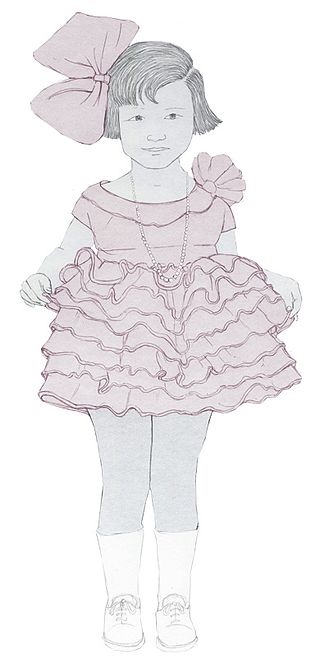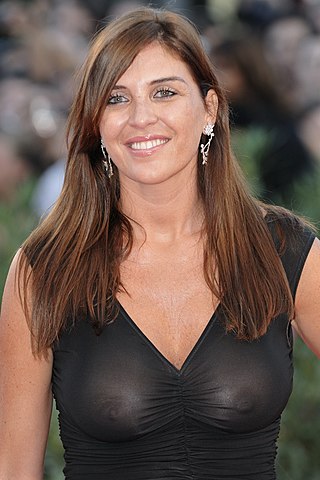Related Research Articles

Calico is a heavy plain-woven textile made from unbleached, and often not fully processed, cotton. It may also contain unseparated husk parts. The fabric is far coarser than muslin, but less coarse and thick than canvas or denim. However, it is still very cheap owing to its unfinished and undyed appearance.

Textile is an umbrella term that includes various fiber-based materials, including fibers, yarns, filaments, threads, different fabric types, etc. At first, the word "textiles" only referred to woven fabrics. However, weaving is not the only manufacturing method, and many other methods were later developed to form textile structures based on their intended use. Knitting and non-woven are other popular types of fabric manufacturing. In the contemporary world, textiles satisfy the material needs for versatile applications, from simple daily clothing to bulletproof jackets, spacesuits, and doctor's gowns.

Muslin is a cotton fabric of plain weave. It is made in a wide range of weights from delicate sheers to coarse sheeting. It gets its name from the city of Mosul, Iraq, where it was first manufactured.
Lawn cloth or lawn is a fine plain weave textile, made with fine combed cotton. Terms also used include batiste and nainsook. Originally the name applied to plain weave linen, and linen lawn is also called "handkerchief linen". The term lawn is also used in the textile industry to refer to a type of starched crisp finish given to a cloth product. The finish can be applied to a variety of fine fabrics, prints or plain.

Ninon is a lightweight, sheer fabric made with plain or leno weaving, it is a suitable material for curtains, evening wear and lingerie. Ninon is made with variety of filament yarns such as polyester, silk, rayon or nylon.

Bands are a form of formal neckwear, worn by some clergy and lawyers, and with some forms of academic dress. They take the form of two oblong pieces of cloth, usually though not invariably white, which are tied to the neck. When worn by clergy, they typically are attached to a clerical collar. The word bands is usually plural because they require two similar parts and did not come as one piece of cloth. Those worn by clergy are often called preaching bands or Geneva bands; those worn by lawyers are called barrister's bands or, more usually in Ireland and Canada, tabs. Preaching bands symbolize the two tablets of the Ten Commandments given by God to Moses.

Broadcloth is a dense, plain woven cloth, historically made of wool. The defining characteristic of broadcloth is not its finished width but the fact that it was woven much wider and then heavily milled in order to shrink it to the required width. The effect of the milling process is to draw the yarns much closer together than could be achieved in the loom and allow the individual fibres of the wool to bind together in a felting process, which results in a dense, blind face cloth with a stiff drape which is highly weather-resistant, hard wearing and capable of taking a cut edge without the need for being hemmed.

Organdy, also spelled Organdie, is a kind of sheer fabric. It is a lightweight balanced plain weave cotton with features of sheerness and crispness.

See-through clothing is any garment of clothing made with lace, mesh or sheer fabric that allows the wearer's body or undergarments to be seen through its fabric. See-through fabrics were fashionable in Europe in the eighteenth century. There was a "sheer fashion trend" starting with designer clothing from 2008. See-through or sheer fabric, particularly in skintone colours, is sometimes called illusion, as in 'illusion bodice' due to giving the impression of exposed flesh, or a revealing ensemble.
The manufacture of textiles is one of the oldest of human technologies. To make textiles, the first requirement is a source of fiber from which a yarn can be made, primarily by spinning. The yarn is processed by knitting or weaving, which turns yarn into cloth. The machine used for weaving is the loom. For decoration, the process of colouring yarn or the finished material is dyeing. For more information of the various steps, see textile manufacturing.
Sewing is the craft of fastening or attaching objects using stitches made with needle and thread. Sewing is one of the oldest of the textile arts, arising in the Paleolithic Era. Although usually associated with clothing and household linens, sewing is used in a variety of crafts and industries, including shoemaking, upholstery, sailmaking, bookbinding and the manufacturing of some kinds of sporting goods. Sewing is the fundamental process underlying a variety of textile arts and crafts, including embroidery, tapestry, quilting, appliqué and patchwork.

Mughal clothing refers to clothing developed by the Mughals in the 16th, 17th and 18th centuries throughout the extent of their empire in the Indian subcontinent. It was characterized by luxurious styles and was made with muslin, silk, velvet and brocade. Elaborate patterns including dots, checks, and waves were used with colors from various dyes including cochineal, sulfate of iron, sulfate of copper and sulfate of antimony were used.
Bafta is a kind of calico, initially made in India.
Sussi or susi was a term for multicolored striped or checked cloth produced in the Indian subcontinent. Sussi was thin handloom fabric made of cotton, silk, or a blend of the two, with colored warp stripes. Punjab region was known for its production and exports during the Mughal period. Sussi was most often made with red and blue, blue and white, or green and white stripes, but other patterns were also produced. The fabric was exported to England, where sousaes were in great demand in the 18th century.

Piece goods were the textile materials sold in cut pieces as per the buyer's specification. The piece goods were either cut from a fabric roll or produced with a certain length, also called yard goods. Various textiles such as cotton, wool, silk, etc., were traded in terms of piece goods. The prices were determined as per the fabric quality.
Tiffany (silk) is a thin, nearly transparent silk fabric similar to gauze, extant more commonly in the 16th and 17th centuries.
Balzarine (Balzorine) was a cotton and worsted fabric of the 19th century. It was a lightweight union cloth made of cotton and wool.

Nun's veiling was a lightweight cloth made of wool. It was a plain weave fabric used mainly for women veils and dresses. Nun's veiling got its name from the fact that it was used in Veils by several religious orders.
Faille is a type of cloth with flat ribs, often made in silk. It has a softer texture than grosgrain, with heavier and wider cords or ribs. Weft yarns are heavier than warp, and it is manufactured in plain weaving. It was especially popular in the 19th century.
Delaine was a kind of mixed cloth with cotton warp and wool in the weft. Delaines have many variations such as made of undyed yarns, and also printed or piece dyed. Delaine was a type of cloth used to manufacture women's dresses that was traded in the nineteenth century under many names to suit importers and traders. Moreover, it appeared that the plaintiffs' goods differed from delaines in various other respects.
References
- ↑ Simmonds, Peter Lund (1872). The Commercial Dictionary of Trade Products, Manufacturing and Technical Terms ... G. Routledge and Sons. pp. 335, 336.
- ↑ Tortora, Phyllis G.; Johnson, Ingrid (2013-09-17). The Fairchild Books Dictionary of Textiles. A&C Black. p. 543. ISBN 978-1-60901-535-0.
- ↑ Montgomery, Florence M. (1984). Textiles in America 1650-1870 : a dictionary based on original documents, prints and paintings, commercial records, American merchants' papers, shopkeepers' advertisements, and pattern books with original swatches of cloth. Internet Archive. New York ; London : Norton. p. 343. ISBN 978-0-393-01703-8.
- 1 2 Thomas Webster, Mrs. William Parkes (1844). An Encyclopaedia of Domestic Economy. p. 981.
Mull muslin is a very thin and soft kind , used for dresses , trimmings , & c . Swiss mull is dressed and stiffened . Seerhand is between nainsork and mull , particularly adapted for dresses , on account of its retaining its clearness after washing.
- ↑ Picken, Mary Brooks (1999-01-01). A Dictionary of Costume and Fashion: Historic and Modern. Courier Corporation. p. 289. ISBN 978-0-486-40294-9.
- ↑ Smith, Henry Percy (1883). Glossary of Terms and Phrases. D. Appleton. p. 436.


